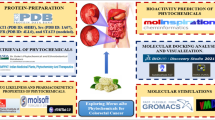Abstract
The interactions between the molecules and DNA shape up an avenue for DNA targeted therapeutics. For the first time, brazilin, a major component of Caesalpinia sappan L., has been investigated for its interaction with natural and synthetic DNA. Detailed analyses of the binding property of brazilin dye with DNA by UV-vis, FTIR and Circular Dichroism were carried out. In addition, in silico studies have been conducted via tools of energy minimization and ligand optimization using Yasara and Argus Lab softwares along with the molecular docking server integrating Auto Dock, Mavin and Mopac. Results show that brazilin dye has commendable proficiency in being moulded as a binder with DNA. The specificity of the dye to stain nuclei in tissue sections positively indicates its interaction with nucleic acid. As the intracellular target for the majority of anticancer and antibiotic drugs is DNA, the study on the interaction between molecules like brazilin and DNA has great significance and implications in several biological applications.
Similar content being viewed by others
References
Bae, I.K., Min, H.Y., Han, A.R., Seo, E.K., Lee, S.K. 2005. Suppression of lipopolysaccharide-induced expression of inducible nitric oxide synthase by brazilin in RAW264.7 macrophage cells. Eur J Pharmacol 513, 237–242.
Bhakta, D., Siva, R. 2012. Morindone, an anthraquinone, intercalates DNA sans toxicity: A spectroscopic and molecular modelling perspective. Appl Biochem Biotechnol 167, 885–896.
Bray, I., Fursa, D.V. 1998. Low-energy electron-impact ionization of helium. Phys Rev A 57, 3161–3164.
Choi, S.Y., Yang, K.M., Jeon, S.D., Kim, J.H., Khil, L.Y., Chang, T.S. 1997. Brazilin modulates immune function mainly by augmenting T cell activity in halothane administered mice. Planta Med 63, 405–408.
Cremazy, F.G.E., Manders, E.M.M., Bastiaens, P.I.H., Kramer, G., Hager, G.L., van Munster, E.B., Verschure, P.J., Gadella, T.W.J., van Driel, R. 2005. Imaging in situ protein-DNA interactions in the cell nucleus using FRET-FLIM. Exp Cell Res 309, 390–396.
Dance, A.M., Raltona, L., Fullera, Z., Milneb, L., Duthie, S., Bestwick, C.S., Lina, P.K.T. 2005. Synthesis and biological activities of bisnaphthalimido polyamines derivatives: Cytotoxicity, DNA binding, DNA damage and drug localization in breast cancer MCF 7 cells. Biochem Pharmacol 69, 19–27.
Dolenc, J., Oostenbrink, C., Koller, J., Gunsteren, W.F. 2005. Molecular dynamics simulations and free energy calculations of netropsin and distamycin binding to an AAAAA DNA binding site. Nucl Acid Res 33, 725–733.
Dutt, M.K. 1982. Basic dyes for the staining of DNA in mammalian tissues and absorption spectra of stained nuclei in the visible light. Microsc Acta 86, 59–68.
Fu, L.C., Xin-an, H., Lai, Z., Hu, Y., Liu, H., Cai, X. 2008. A new 3-benzylchroman derivative from Sappan Lignum (Caesalpinia sappan). Molecules 13, 1923–1930.
Hobza, P., Cubero, E., Orozco, M., Luque, F.J. 1999. Hydrogen bond versus anti-hydrogen bond: A comparative analysis based on the electron density topology. J Phys Chem A 103, 6394–6401.
Hwang, G.S., Kim, J.Y., Chang, T.S., Jeon, S.D., So, D.S., Moon, C.K. 1998. Effects of brazilin on the phospholipase A2 activity and changes of intracellular free calcium concentration in rat platelets. Arch Pharmacal Res 21, 774–778.
Kanakis, C.D., Tarantilis, P.A., Tajmir-Riahi, H.A., Polissiou, M.G. 2008. DNA interaction with saffron’s secondary metabolites safranal, crocetin, and dimethylcrocetin. DNA Cell Biol 26, 63–70.
Mok, M.S., Jeon, S.D., Yang, K.M., So, D.S., Moon, C.K. 1998. Effects of brazilin on induction of immunological tolerance by sheep red blood cells in C57BL/6 female mice. Arch Pharmacal Res 21, 769–773.
Moon, C.K., Park, K.S., Kim, S.G., Won, H.S., Chung, J.H. 1992. Brazilin protects cultured rat hepatocytes from trichlorobromethane-induced toxicity. Drug Chem Toxicol 15, 81–91.
Puchtler, H., Meloan, S.N., Waldrop, F.S. 1986. Application of current chemical concepts to metal hematein and brazilin stains. Histochemistry 85, 353–364.
Rajendra, T.K., Gonsalvez, G.B., Walker, M.P., Shpargel, K.B., Salz, H.K., Matera, A.G. 2007. A Drosophila melanogaster model of spinal muscular atrophy reveals a function for SMN in striated muscle. J Cell Biol 176, 831–841.
Reddy, B.S., Sondhi, S.M., Lown, J.W. 1999. Synthetic DNA minor groovebinding drugs. Pharmacol Ther 84, 1–111.
Siva, R. 2007. Status of natural dyes and dye yielding plants in India. Curr Sci 92, 916–925.
Sponer, J., Leszczynski, J., Hobza, P. 1996. Structures and energies of hydrogen-bonded DNA base pairs. A nonempirical study with inclusion of electron correlation. J Phys Chem 100, 1965–1974.
Vaidyanathan, V.G., Nair, B.U. 2005. Synthesis, characterization and DNA-binding studies of mixed ligand complexes of ruthenium(II) with DNA. J Chem Soc Dalton Trans 17, 2842–2848.
Vijayalakshmi, R., Mookandi, K., Venkatesan, S., Nair, B.N. 2000. DNA cleavage by a chromium (III) complex. Biochem Biophys Res Commun 271, 731–734.
Zhang, L.Z., Tang, G.Q. 2004. The binding properties of photosensitizer methylene blue to herring sperm DNA: a spectroscopic study. J Photochem Photobiol B: Bio 74, 119–125.
Author information
Authors and Affiliations
Corresponding author
Electronic supplementary material
Rights and permissions
About this article
Cite this article
Bhakta, D., Lulu, S., Jayaraman, G. et al. Interaction of plant pigment brazilin with synthetic and natural DNA: Spectroscopic and in silico perspective. Interdiscip Sci Comput Life Sci 5, 53–59 (2013). https://doi.org/10.1007/s12539-013-0148-y
Received:
Revised:
Accepted:
Published:
Issue Date:
DOI: https://doi.org/10.1007/s12539-013-0148-y




